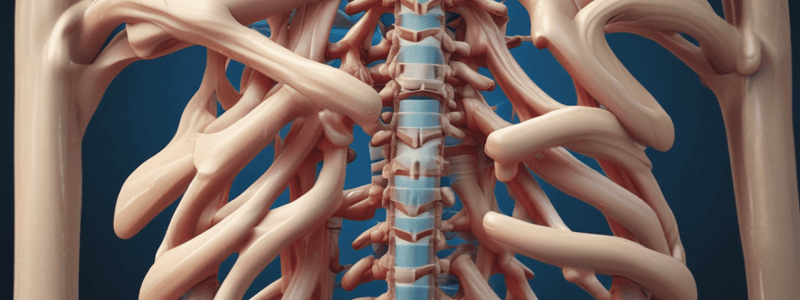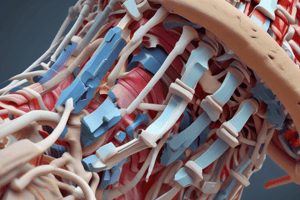Podcast
Questions and Answers
During extension, the disc becomes flatter posteriorly and thicker anteriorly.
During extension, the disc becomes flatter posteriorly and thicker anteriorly.
True (A)
Extension increases the size of the opening of the intervertebral foramina.
Extension increases the size of the opening of the intervertebral foramina.
False (B)
During extension, the nucleus is pushed posteriorly towards neural tissue.
During extension, the nucleus is pushed posteriorly towards neural tissue.
False (B)
The posterior longitudinal ligament is under increased tension during extension.
The posterior longitudinal ligament is under increased tension during extension.
Lateral flexion causes the upper vertebra to tilt on the side of flexion.
Lateral flexion causes the upper vertebra to tilt on the side of flexion.
During lateral flexion, the disc becomes thicker on both sides.
During lateral flexion, the disc becomes thicker on both sides.
The capsular ligament of the facet joint relaxes contralaterally during lateral flexion.
The capsular ligament of the facet joint relaxes contralaterally during lateral flexion.
The articular processes of the upper and lower vertebrae glide less during extension.
The articular processes of the upper and lower vertebrae glide less during extension.
The direction of rotation that accompanies lateral flexion is the same in all regions.
The direction of rotation that accompanies lateral flexion is the same in all regions.
Rotational forces combined with compressive and flexion forces pose the least risk of injury.
Rotational forces combined with compressive and flexion forces pose the least risk of injury.
The Ligamentum nuchae is involved in limiting axial rotation.
The Ligamentum nuchae is involved in limiting axial rotation.
The intertransverse ligament limits lateral flexion in the lumbar region.
The intertransverse ligament limits lateral flexion in the lumbar region.
The Capsule of the apophyseal joints is involved in limiting axial rotation.
The Capsule of the apophyseal joints is involved in limiting axial rotation.
The Alar ligament is related to limiting lateral flexion in the craniocervical region.
The Alar ligament is related to limiting lateral flexion in the craniocervical region.
The anterior annulus fibrosus restricts extension.
The anterior annulus fibrosus restricts extension.
The posterior longitudinal ligament limits lateral flexion.
The posterior longitudinal ligament limits lateral flexion.
Shear acts on the midplane of the disk and tends to cause each vertebra to move anteriorly, posteriorly, or from side to side in relation to the superior vertebra.
Shear acts on the midplane of the disk and tends to cause each vertebra to move anteriorly, posteriorly, or from side to side in relation to the superior vertebra.
The apophyseal joints in the lumbar spine resist all shear force while the disks resist the remainder.
The apophyseal joints in the lumbar spine resist all shear force while the disks resist the remainder.
The movements of the spine at each level involve large ranges of elementary movements.
The movements of the spine at each level involve large ranges of elementary movements.
During flexion, the intervertebral disc becomes thicker anteriody and thinner posteriorly.
During flexion, the intervertebral disc becomes thicker anteriody and thinner posteriorly.
Rotation of the spine compresses and bulges the posterior side of the annulus fibrosus.
Rotation of the spine compresses and bulges the posterior side of the annulus fibrosus.
Flexion transfers load from the intervertebral discs to the apophyseal joints.
Flexion transfers load from the intervertebral discs to the apophyseal joints.
During flexion, the inferior articular processes of the upper vertebra glide downwards.
During flexion, the inferior articular processes of the upper vertebra glide downwards.
The ligaments that limit flexion include the ligamentum flavum and supraspinous ligament.
The ligaments that limit flexion include the ligamentum flavum and supraspinous ligament.




